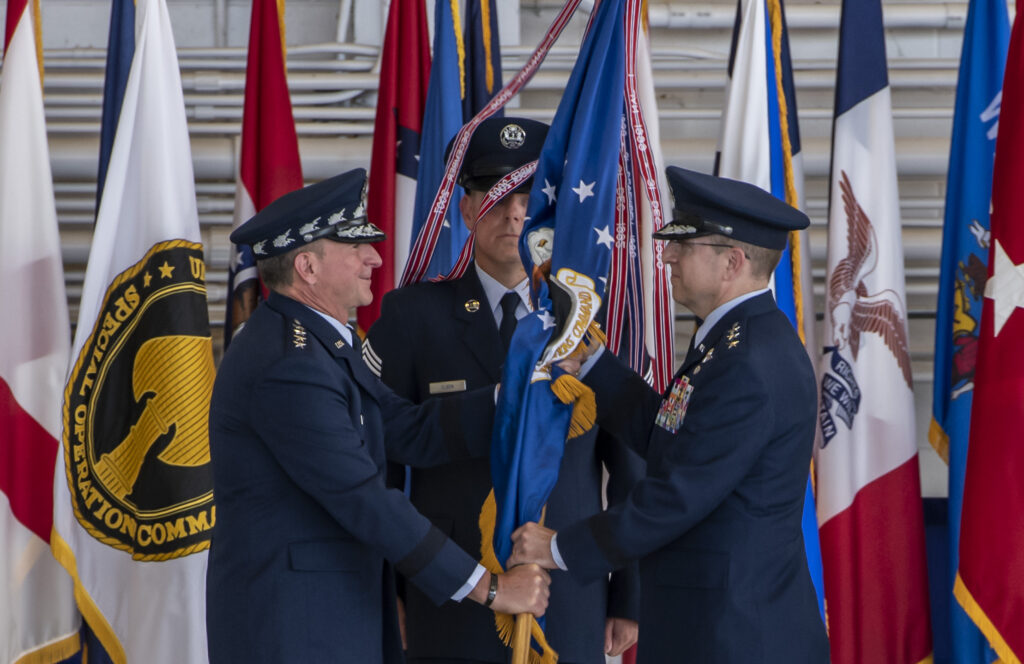
Lt. Gen. Jim Slife (right) and Air Force Chief of Staff Gen. David Goldfein (left)
WASHINGTON: Air Force Special Operations Command must better integrate cyber, space and information operations as the US military pivots to All Domain Operations from a focus on combatting terrorism, according to a new AFSOC strategy document.
“It will induce short-term institutional turbulence, require us to question long-held assumptions, and compel us to make the difficult choices necessary to our transformation,” Lt. Gen. Jim Slife said in a memo to all of AFSOC.
The new AFSOC Strategic Guidance, obtained by Breaking Defense, details Slife’s intentions to invest in human capital, reorganize to better meet joint force requirements, and modernize across a wide swathe of capabilities. Key to the strategy is a focus on Joint All Domain Command and Control (JADC2), DoD’s effort to link all shooters to all sensors across all domains, the document says.
“AFSOC will expand our expertise in domain integration to meet emerging requirements by developing organic cyber delivery, growing our investment in information operations, and strengthening our operational integration with space assets. These effects will connect to the joint force with resilient networking to ensure AFSOC forces are fully integrated with joint all-domain command and control (JADC2), both inside and outside the areas contested by our adversaries.”
The strategy details measures to invest in human capital first and foremost, including reorganizing to undertake “full spectrum operations” designed to “solve high priority problems for the joint force.”
Slife, speaking to reporters at the annual Air Force Association winter meeting in Orlando on Feb. 27, said that “the fundamental premise that we came to as we looked at this is that our human capital is our competitive advantage, and this is really the thing we ought to invest in.”
The strategy document notes that in recent years AFSOC has become used to being a supported command focused almost solely on counter-terrorism, but the shift in US priorities toward peer and near peer conflict will change that — thus requiring retraining, new organizational structures and new equipment.
This translates into three requirements for the future fight, the strategy says:
“First, AFSOC will employ low-visibility capabilities to identify high-value targets in denied areas and contribute to the joint force’s ability to link those targets with desired effects. Second, AFSOC will leverage its access and placement to provide organic all-domain fires to open windows of opportunity the joint force can then exploit with mass. Finally, AFSOC will provide the joint force unique options to impose costs and hold adversaries at risk outside immediate conflict zones with a comparatively low risk of horizontal escalation.”
The vision also sets out plans to divest of older systems in order to afford modernization, with a gimlet eye on emerging technologies such as artificial intelligence. Communications, survivable strike, mobility, high-speed vertical lift, and ISR capabilities are all on the modernization list, according to the document.
Slife said in his AFA briefing that, while Special Operations Command has acquisition authority for a new Armed Overwatch aircraft to replace AFSOC’s U-28s, AFSOC has been working on requirements for the new plane. “It is ultimately a SOCOM requirement,” he said.
The Pentagon’s 2021 budget requests some $106 million for SOCOM to acquire the first five of a planned 75 or so low-cost armed overwatch aircraft.
Slife explained that the Armed Overwatch planes will be different from the Air Force’s concept for light attack aircraft. SOCOM isn’t set on a highly maneuverable, close air support (CAS) fighter jet, he said.
“It doesn’t have to be a fighter, ” Slife said. “We view it as an airplane that will employ CAS procedures.”
Instead, SOCOM is looking at commercially available aircraft such as crop dusters or business jets.
As reported by colleague Valerie Insinna, the Air Force in February finally decided after years of dithering that it is not going to buy after years of dithering, the Air Force decided against buying light attack aircraft in quantity. It is going ahead with a buy of two AT-6 Wolverine aircraft built by Textron and two A-29 Super Tucanos built by Sierra Nevada Corp. and Embraer. Both are turboprop planes.
Clearing smoke: Boeing swapping out AH-64E Apache generators, eyes new generator options
“We’ve seen some improvement … and so readiness is there: We have enough retrofit generators right now [and] it’s not impacting readiness,” said John Chicoli, the director of Boeing’s global services for vertical lift and special operations.


























